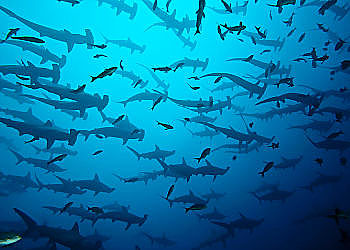 Wild, spectacular, intoxicating Malpelo. Renowned for its abundance of schooling sharks & pelagic encounters, this is a “must do” destination for every adventurous diver.
Wild, spectacular, intoxicating Malpelo. Renowned for its abundance of schooling sharks & pelagic encounters, this is a “must do” destination for every adventurous diver.
SCUBA HIGHLIGHTS
PINNACLES, vertical walls, tunnels, caves, SWIM-THROUGHS & sandy bottoms are home to countless GALAPAGOS SHARKS, throngs of SILKY SHARKS & swirling schools of HAMMERHEAD SHARKS … plus playful DOLPHINS ready to engage with divers. Add in breathtaking PACIFIC MANTAS innumerable eagle rays doing fly-bys enormous WHALE SHARKS, JUMBO-SIZED SCHOOLS of snappers, jacks, tuna and barracuda and the occasional SAILFISH & the rare small-tooth sandtiger shark. Then … you have the ubiquitous green moray eels & endemic RED-LIPPED BATFISH … and, finally, CORAL LIFE that attracts tropical fish: surgeonfish, angelfish, damselfish, Moorish idols, trumpet fish. A diving rush you have to feel to imagine.
WILD AND SPECTACULAR
This is a wild & spectacular marine environment, renowned for its abundance and quantity of schooling shark and big marine animal encounters. The island itself, is forbidding … standing strong against the formidable elements in the eastern Pacific. When Malpelo diving is at its best, only Cocos & Galapagos can roughly compare with the numbers of sharks and big fish in the water.
You have schools of hammerheads (up to 300 animals in one school) and silky sharks, plus a variety of other shark species, such as the Galapagos shark, whale shark and white-tip shark, together with huge schools of other big fish species – giant schools of angelfish, Creole fish, jacks, tuna, and occasionally a sailfish.
PASSING PELAGICS & YEAR-ROUND RESIDENTS
You often find a passing whale shark and even humpback whales and blue whales. The rare, deep water ragged-tooth shark also can be encountered in the colder depths
Malpelo is located at a site of convergence of different major currents in the Pacific Ocean: the cold Humboldt current (south-north), the warm North-Equatorial (west-east) counter-current, and from January to March, the cold cyclonic Panama current (north-south). It is these conflicting cold currents and warm equatorial currents which create conditions ripe for a sea rich in nutrients and therefore also rich in marine species.
Hammerhead sharks can be seen all year round but due to thermoclines in shallower depths they tend to be more numerous from December to March. Also, in the first three months of the year the temperature below the thermocline is colder and the smalltooth sand tiger shark ascends to depths accessible for recreational divers.
Silky sharks are more prevalent in the months of April to September. In addition to the residing eagle rays, mobula and the majestic manta rays can be experienced in the months of May and June.
In April and May divers are usually lucky enough to see great hunting expeditions in which a variety of the animals chase baitballs of fish. June is the month of the arrival of whale sharks which stay along with the Galapagos sharks until September.
Warmer water temperatures and thermoclines in deeper water are found from June to November.

A GLIMPSE OF MALPELO’S TREASURES
{slider  Malpelo diving
Malpelo diving
This area has one of the biggest hammerhead shark populations in the world, in addition to silkies, white tips, whale sharks, plus countless schools of fish, several ray species and the giant manta. There are approximately 20 dive spots at Malpelo and it’s a paradise for shark lovers! You’ll find plenty of other amazing wildlife: hundreds of morays swimming in open water near the walls, schools of barracuda, turtles, dolphins, schools of mantas and spotted eagle rays, whale sharks, white-tip sharks, bull sharks, schools of silky sharks, galapagos sharks, amberjacks, tunas, snappers, groupers, huge schools of jack fish and those amazing free-swimming eels…. read more …|dest|closed}
But, what makes Malpelo unique in the world is the incredible concentration of hammerheads. They swim in schools of hundreds are usually visible between 10 and 30 meters deep. Swimming peacefully from morning to night, they seem indifferent to what happens around them. Diving with them is a once in a lifetime experience! {/sliders}
Malpelo, a giant in terms of the marine world, is just a tiny island lying in the East Pacific Ocean, located roughly 500 kilometers (310 miles) west of Colombia. It’s the only peak which extends above the waterline from an ancient volcanic ridge & is uninhabited except for a small military post. The Malpelo Nature Reserve, a plant & wildlife sanctuary, surrounds the island. Also, in 2006, Malpelo was declared a UNESCO World Heritage Site.
